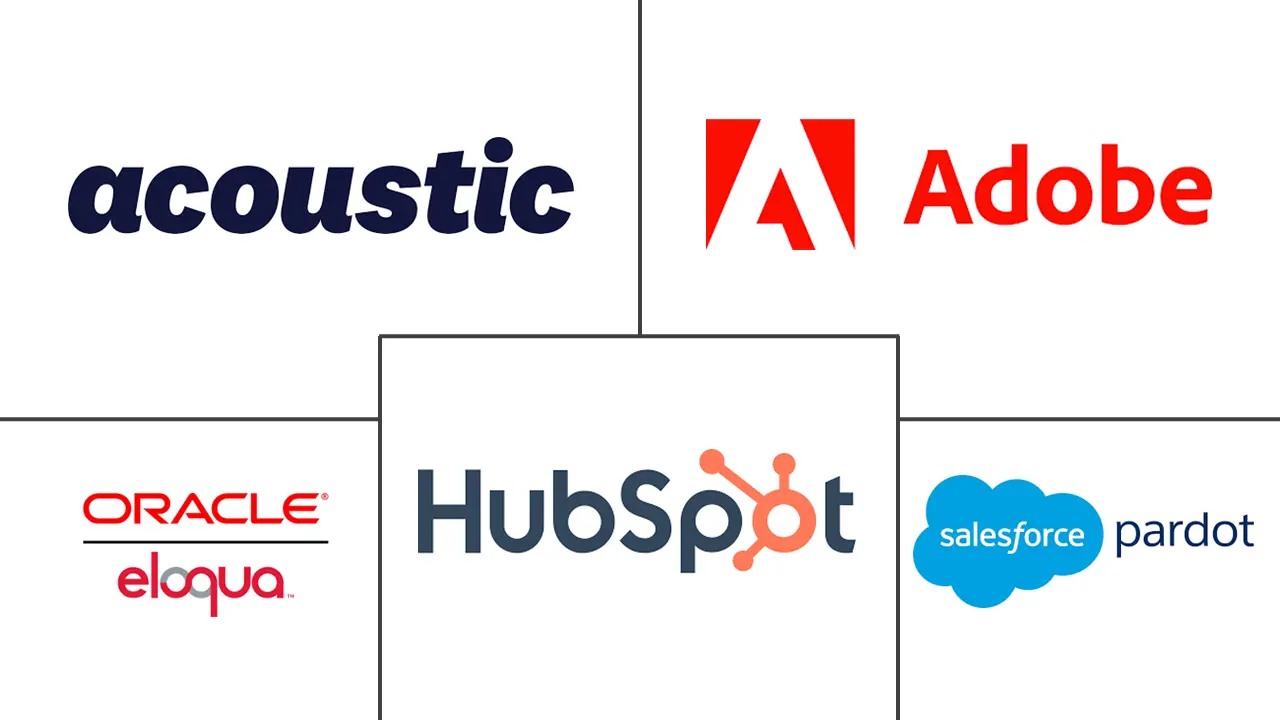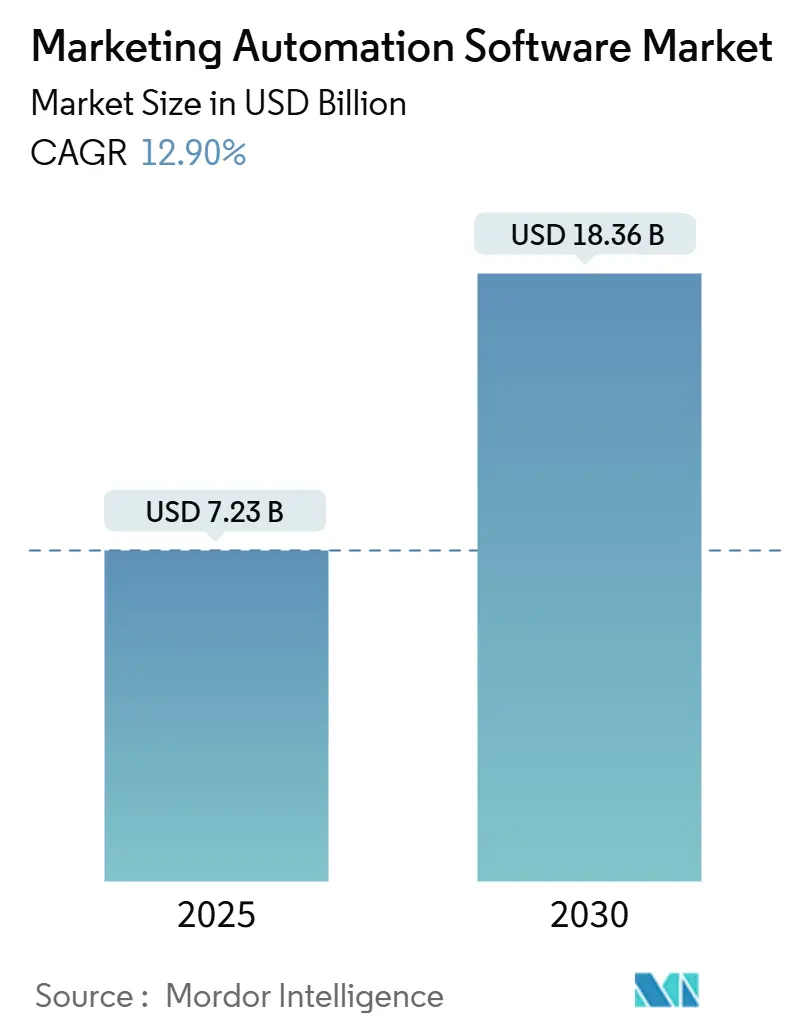
Marketing Automation Software Market Analysis by Mordor Intelligence
The global marketing automation software market size stands at USD 7.23 billion in 2025 and is on track to reach USD 18.36 billion by 2030, reflecting a solid 12.9% CAGR. This growth mirrors enterprises’ rapid pivot toward AI-driven engagement hubs that bolt onto existing CRM systems and orchestrate real-time campaigns across channels. Advancing generative AI now writes copy, selects offers and times delivery in milliseconds, letting brands scale “one-to-one” messaging without ballooning headcount. Demand also rises as privacy regulations tighten, pushing firms to automate consent tracking and data lineage. Meanwhile, mid-market buyers rely on cloud subscription models to bypass capital outlays, widening the user base and intensifying vendor competition in every region of the marketing automation software market.
Key Report Takeaways
- By component, software accounted for a commanding 69.2% of 2024 revenue, whereas the services segment is forecast to expand at a 14.0% CAGR through 2030.
- By deployment, cloud solutions captured 66.3% share in 2024; on-premise installs persist mainly in tightly regulated verticals, yet hybrid cloud is gaining traction at a 13.9% CAGR.
- By organization size, large enterprises controlled 62.5% of the marketing automation software market share in 2024, but SMEs represent the fastest-growing cohort with a 15.2% CAGR through 2030.
- By application, email marketing led with 27.9% revenue in 2024, while analytics and reporting will deliver the highest growth at 18.0% CAGR.
- By vertical, BFSI contributed 20.0% of 2024 demand; retail and e-commerce stand out with a 17.7% CAGR to 2030.
- By region, North America held 37.5% revenue in 2024; Asia-Pacific is projected to advance at a 15.8% CAGR through 2030.
Global Marketing Automation Software Market Trends and Insights
Drivers Impact Analysis
| Driver | (~) % Impact on CAGR Forecast | Geographic Relevance | Impact Timeline |
|---|---|---|---|
| Increase in SMB-first Cloud Adoption Surge Across Emerging Asia | +2.1% | Asia-Pacific core, spill-over to MEA | Medium term (2-4 years) |
| AI-Powered Hyper-Personalization Boosting Campaign ROI | +3.2% | Global, with early gains in North America and EU | Short term (≤ 2 years) |
| Integration of Composable CDPs with CRM Suites | +1.8% | North America and EU, expanding to Asia-Pacific | Medium term (2-4 years) |
| Compliance-Led Omnichannel Expansion in BFSI | +1.4% | Global, concentrated in regulated markets | Long term (≥ 4 years) |
| Adoption of WeChat Mini-App Automation Boom in Mainland China | +1.7% | China-focused, limited regional spill-over | Short term (≤ 2 years) |
| Source: Mordor Intelligence | |||
SMB-first cloud adoption surge across emerging Asia
Small and medium enterprises in Asia-Pacific now devote 3–5% of annual revenue to digital upgrades, positioning cloud-native marketing stacks as an essential plank of growth plans. Regional policymakers draft “AI Basic Laws” and fund workforce skilling, lowering compliance risk and reducing onboarding friction for newcomers. Manufacturing outlays on smart-factory systems rose 48% in 2024, creating spill-over demand for customer-facing automation that syncs with upstream production data.[1]Rockwell Automation, “Smart Tech Success Blog,” rockwellautomation.com These tailwinds jointly lift the marketing automation software market across high-growth Asian economies.
AI-powered hyper-personalization boosting campaign ROI
Generative AI removes the content bottleneck that once limited customer-specific messaging. Early adopters already compress campaign launch cycles and re-route budgets toward predictive models that anticipate intent and auto-generate assets, a capability underpinned by soaring global AI patent activity (+62.7% YoY). [2]PatentPC, “AI Innovations: Patent Statistics and Trends,” patentpc.com Vendors bundle large-language-model co-pilots into core platforms, accelerating usage and adding measurable lift in open rates, conversions and lifetime value.
Integration of composable CDPs with CRM suites
Enterprises are re-architecting around modular, API-first CDPs that treat marketing automation as a plug-in rather than a silo. The CRM sector itself is set to top USD 262.74 billion by 2032, validating a unified-data thesis that improves attribution accuracy and eliminates swivel-chair workflows.[3] Oracle Corporation, “Investor Relations – Financials,” oracle.com As IT teams press for stack rationalization, the marketing automation software market benefits from cross-sell momentum inside existing CRM footprints.
Compliance-led omnichannel expansion in BFSI
Eight new U.S. state privacy statutes that go live in 2025—plus parallel rules emerging in Europe and Asia—force banks and insurers to embed consent management and audit trails directly into engagement flows. Automation platforms offering baked-in governance win faster approvals, turning regulatory complexity into a growth catalyst over the long term.
Restraints Impact Analysis
| Restraint | (~) % Impact on CAGR Forecast | Geographic Relevance | Impact Timeline |
|---|---|---|---|
| Multi-Vendor MarTech Stack Integration Overheads in Heavy-Industry Manufacturing | -1.9% | Global, concentrated in industrial regions | Medium term (2-4 years) |
| Mid-Market Talent Shortage in Marketing Ops Across EMEA | -1.3% | EMEA core, emerging in APAC | Long term (≥ 4 years) |
| SaaS Subscription Fatigue Driving Higher Tool Churn in SMBs | -0.8% | Global, particularly North America & EU | Short term (≤ 2 years) |
| Source: Mordor Intelligence | |||
Multi-vendor MarTech stack integration overheads in heavy-industry manufacturing
Plant operators run legacy ERP and shop-floor systems with long rotor cycles and bespoke data models, so layering in modern engagement tools demands extensive interface work. Integration projects inflate budgets by up to 60% versus green-field deployments, lengthening time-to-value and dampening appetite among cost-sensitive manufacturing buyers.
Mid-market talent shortage in marketing ops across EMEA
Companies report that 48.6% of automation investments under-perform because teams lack the architects, data engineers and workflow specialists needed to exploit advanced features. Salary premiums for certified platform engineers strain OPEX, slowing uptake outside tier-one hubs.
Segment Analysis
By Component – Services Gain Momentum as Complexity Rises
Software retained 69.2% revenue in 2024, underscoring its role as the entry ticket to the marketing automation software market. Yet as AI modules, data-clean rooms and omnichannel hubs proliferate, enterprises increasingly contract specialized partners for integration, optimization and governance. Consequently, services are forecast to clock a 14.0% CAGR, outpacing product, and capturing a larger slice of the marketing automation software market size by 2030.
Consulting teams now absorb 30–40% of total project spend, reflecting the move from license-centric deals to outcome-centric programs. Oracle’s cloud services revenue of USD 5.9 billion in Q2 FY2025 illustrates the scale of post-sale value creation that accompanies platform uptake.
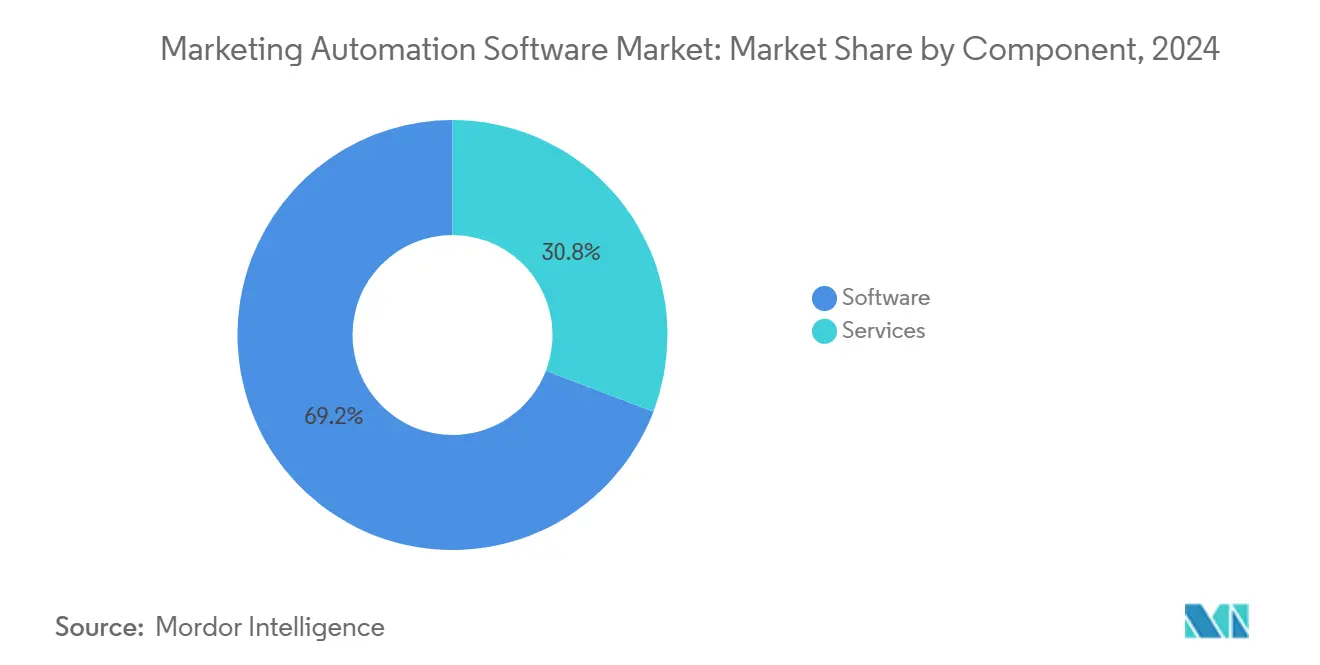
Note: Segment shares of all individual segments available upon report purchase
By Deployment – Cloud Dominates but Hybrid Persists
Cloud subscriptions held 66.3% of 2024 spend and will advance at 13.9% CAGR as CIOs prize elasticity, auto-patching and rapid AI feature drops. The marketing automation software market size linked to cloud offerings therefore widens each quarter. Nevertheless, banks, telcos and public bodies still keep sensitive datasets on-premise, giving rise to hybrid models that shuttle non-PII workloads to public clouds while anchoring core ledgers on private infrastructure. Microsoft tallied USD 137.4 billion in cloud revenue in 2024, evidence of entrenched demand for scalable back-ends that power engagement suites.
By Organization Size – SMEs Close the Gap
Large enterprises commanded most revenue in 2024, yet SMEs already expand 15.2% annually. Subscription pricing, low-code setups and template libraries allow firms with lean teams to deploy full-funnel journeys in weeks. This democratization pulls new budgets into the marketing automation software market while diversifying vendor roadmaps toward self-service. Startia Holdings’ BowNow captured 22.9% of Japan’s SME segment by aligning packaging and support with local buyer needs.
By Application – Analytics Rises Even as Email Retains Reach
Email workflows still generated 27.9% of 2024 revenue, reinforcing the channel’s universal reach and low unit cost. Yet analytics and reporting tools will expand at 18.0% CAGR because marketing leaders now benchmark spend against multi-touch attribution and predictive lifetime value. As a result, analytics will account for a growing proportion of the marketing automation software market share over the forecast horizon. AI-assisted dashboards close feedback loops in real time, feeding next-best-action engines that lift cross-sell and upsell metrics.
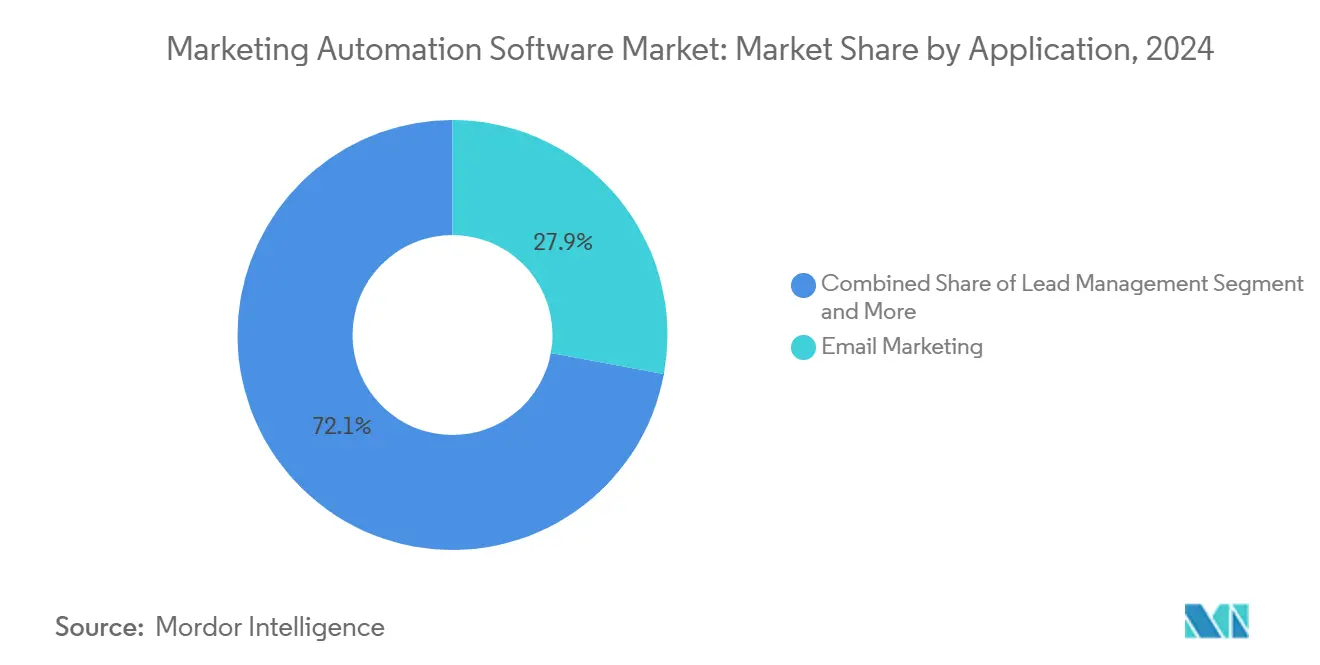
Note: Segment shares of all individual segments available upon report purchase
By End-user Vertical – Retail Closes in on BFSI Leadership
Financial institutions captured 20.0% of 2024 demand owing to stringent compliance requirements and high customer acquisition costs. Retail and e-commerce are set to post a 17.7% CAGR as dynamic pricing, inventory-linked triggers and super-app ecosystems (e.g., WeChat Mini-Programs) reshape customer journeys. The intersection of unified commerce and privacy-safe data activation underpins strong upside for retail players within the marketing automation software market.
Geography Analysis
North America contributed 37.5% of 2024 revenue, sustained by mature cloud infrastructure, an active venture funding scene and early-mover advantage among Fortune 500 marketers. Sweeping state-level privacy acts effective in 2025 accelerate adoption of platforms with in-built consent orchestration, further entrenching automation rather than curtailing it. The region additionally benefits from dense partner ecosystems that shorten implementation cycles.
Asia-Pacific is the fastest-growing territory, expanding 15.8% per year as cloud affordability intersects with large digitally native SME populations. Government incentives, such as Korea’s AI tax credits and semiconductor export programs, add infrastructure depth and lower latency for real-time personalization workloads. China’s 1.3 billion WeChat users amplify the addressable audience for embedded mini-app automation, translating into outsized platform growth relative to legacy channels.
Europe, South America, the Middle East and Africa together form a diversified opportunity base. In the EU, GDPR heritage keeps compliance features top-of-mind, yet a shortage of marketing operations talent inhibits full-scale rollouts. Latin American firms leapfrog on-premise by moving straight to cloud suites, while Gulf-region banks pilot AI chat-led onboarding to reach unbanked segments. Collectively, these trends channel incremental revenue into the marketing automation software market despite heterogeneous macro conditions.
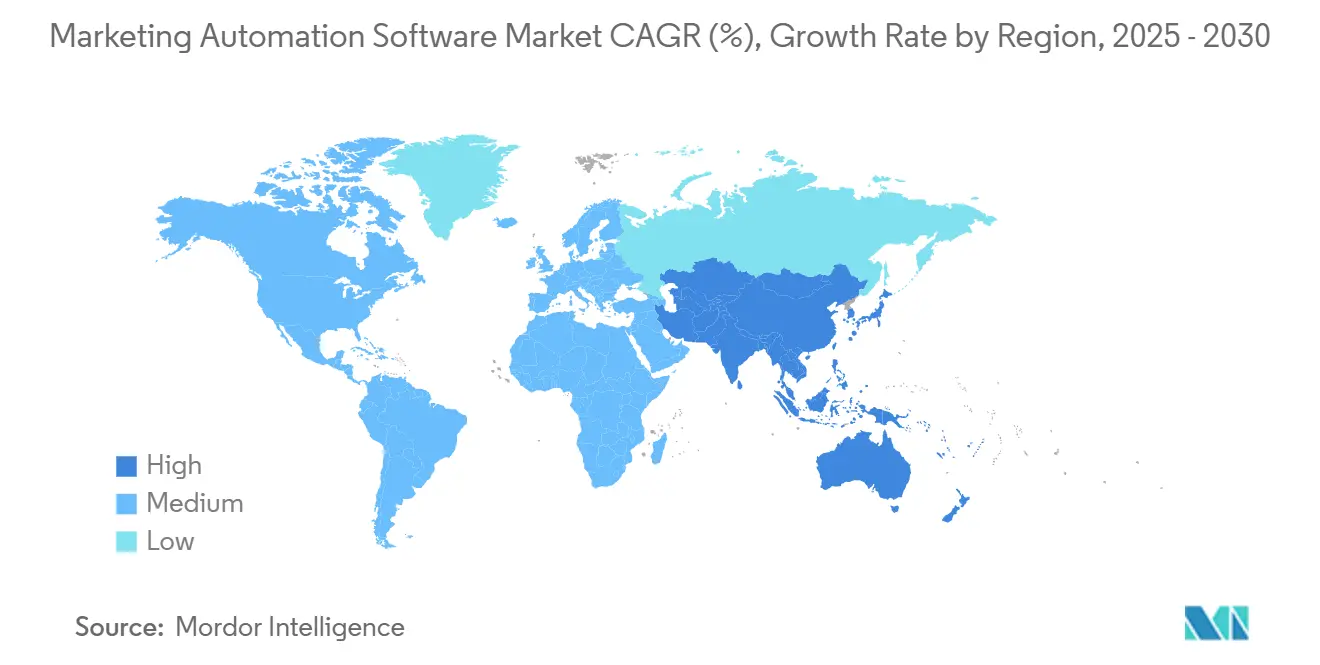
Competitive Landscape
The marketing automation software market shows moderate concentration. HubSpot, Salesforce, Adobe, Microsoft and Oracle hold sizeable combined share, but no single vendor exceeds 40%, creating room for challengers to differentiate through vertical depth or AI specificity. Incumbents double down on platform breadth, embedding generative AI co-pilots and acquiring niche analytics firms to fill gaps. Oracle’s GPU consumption spike of 336% in Q2 FY2025 signals aggressive AI scaling to defend share.
Emerging vendors target white spaces: customer-data-platform specialists pitch composable blueprints to global retailers; fintech-focused suites bake regulatory workflows into native objects; and Asia-based suppliers localize for super-app ecosystems rather than e-mail centricity. Patent race intensity—IBM and Baidu alone control more than 20,000 AI-marketing patents—suggests IP portfolios will increasingly influence purchase decisions and partnership patterns.
Strategic moves in 2024-2025 include Microsoft’s deeper Dynamics 365 integrations, Adobe’s AI-first content generation upgrades, and Startia Holdings’ channel expansion across Southeast Asia. Taken together, these initiatives illustrate how large and mid-tier players balance innovation with go-to-market specialization to secure incremental wallet share within the marketing automation software market.
Marketing Automation Software Industry Leaders
-
HubSpot, Inc.
-
Adobe Systems Inc.
-
Oracle Corporation (Eloqua)
-
Acoustic L.P.
-
Salesforce Inc. (Pardot & Marketing Cloud)
- *Disclaimer: Major Players sorted in no particular order
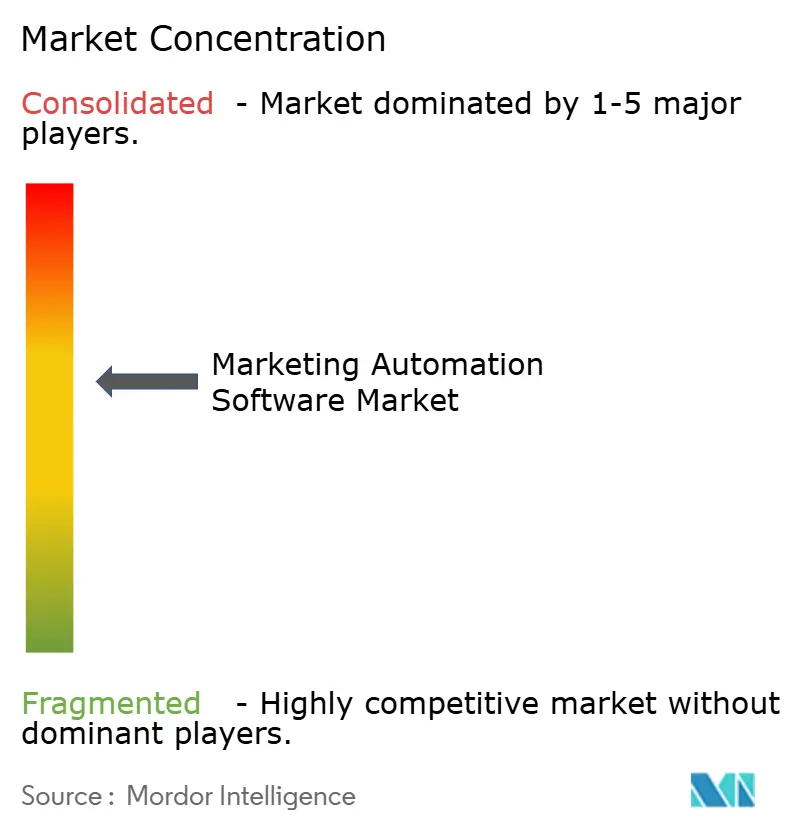
Recent Industry Developments
- May 2025: Oracle posted Q2 FY2025 revenue of USD 14.1 billion, with cloud services up 24% to USD 5.9 billion as accelerated GPU uptake powers real-time marketing workloads. The company will channel rising cash flow into unified CX-automation roadmaps aimed at regulated industries.
- March 2025: HubSpot closed 2024 at USD 2.6 billion revenue, up 25% YoY, and announced expansion of its Commerce Hub to tighten sales-marketing payment loops. The strategy locks customers deeper into its flywheel model, reinforcing platform stickiness.
- January 2025: Startia Holdings reported digital-marketing segment profit growth of 214.7% YoY, fueled by BowNow adoption among Japanese SMEs. Management will leverage the profit surge to bolster R&D on AI behavioral scoring.
- February 2025: Lenovo’s CIO Playbook revealed that 41% of APAC technology budgets are earmarked for generative AI, underscoring near-term demand for AI-native marketing suites.
Research Methodology Framework and Report Scope
Market Definitions and Key Coverage
According to Mordor Intelligence analysts, our study treats the global marketing automation software market as the universe of licensed or subscription-based platforms and related modules that automatically execute, manage, and analyze repetitive marketing tasks across email, social, web, mobile, and lead-capture channels. The definition includes packaged solutions sold as standalone suites or integrated within CRM stacks that generate recurring software revenue.
Scope Exclusions: We purposely exclude one-off professional services and in-house, custom-built scripts that are not commercially supported.
Segmentation Overview
- By Component
- Software
- Services
- By Deployment
- Cloud-based
- On-Premise
- By Organization Size
- Large Enterprises
- Small and Medium Enterprises (SMEs)
- By Application
- Campaign Management
- Email Marketing
- Lead Management
- Analytics and Reporting
- Social Media Marketing
- Mobile Marketing
- Inbound Marketing
- Sales Enablement
- Other Applications
- By End-user Vertical
- BFSI
- Retail and E-commerce
- IT and Telecom
- Healthcare
- Manufacturing
- Media and Entertainment
- Government
- Education
- Other End-user Verticals
- By Geography
- North America
- United States
- Canada
- Mexico
- Europe
- Germany
- United Kingdom
- France
- Italy
- Spain
- Nordics
- Rest of Europe
- Asia-Pacific
- China
- Japan
- India
- South Korea
- Singapore
- Indonesia
- Rest of Asia-Pacific
- South America
- Brazil
- Argentina
- Chile
- Rest of South America
- Middle East
- United Arab Emirates
- Saudi Arabia
- Turkey
- Israel
- Rest of Middle East
- Africa
- South Africa
- Egypt
- Nigeria
- Rest of Africa
- North America
Detailed Research Methodology and Data Validation
Primary Research
Our analysts held structured interviews and short surveys with software vendors, digital agencies, and end-user managers across North America, Europe, and Asia Pacific. These conversations clarified average selling prices, churn rates, and adoption triggers, and helped fine-tune assumed pay-as-you-go pricing tiers.
Desk Research
We gathered foundational supply and demand indicators from open reports published by bodies such as the International Telecommunication Union, United States Census Bureau, Eurostat, and the Interactive Advertising Bureau. Company 10-Ks, investor decks, annual SaaS benchmarks, and public procurement data helped us size vendor penetration by region and industry. Access to D&B Hoovers and Dow Jones Factiva provided spend benchmarks and deal news that anchored trend direction. This list is illustrative; many other secondary references supported validation.
Market-Sizing & Forecasting
We started with a top-down reconstruction that scaled global enterprise IT budgets against verified marketing-technology spending ratios, which are then split by automation penetration. Select bottom-up roll-ups of leading vendor revenues, channel checks, and sampled ASP × user counts were used to cross-check totals once and adjust for freemium tiers. Key variables in the model include email volume per firm, cloud marketing spend share, SMB digitalization rates, and regional GDP-per-capita, each projected through a multivariate regression to 2030. Forecast curves were stress tested through scenario analysis to reflect macro slowdowns and privacy regulation shifts.
Data Validation & Update Cycle
Before publication, Mordor analysts run every figure through a three-level review; anomaly flags trigger re-contact with sources, and material news events prompt interim refreshes. Our dashboards are revisited annually, so clients always receive an updated baseline.
Why Mordor's Marketing Automation Software Baseline Commands Reliability
Published estimates rarely agree because firms differ on what revenue streams count, how fast cloud adoption grows, and which currencies anchor their base year. Mordor Intelligence applies a disciplined scope, yearly refresh cadence, and pricing realignment that keep its totals reproducible.
Key gap drivers include inclusion of professional services, use of aggressive seat-expansion ratios, or outdated vendor lists. Where others inflate totals by blending broader digital-experience spending, we limit inputs to pure-play automation software and reconcile every assumption with live interviews.
Benchmark comparison
| Market Size | Anonymized source | Primary gap driver |
|---|---|---|
| USD 7.23 B | Mordor Intelligence | - |
| USD 7.39 B | Global Consultancy A | Counts managed services as software licensing |
| USD 7.46 B | Industry Journal B | Applies uniform 20 percent price uplift across regions |
| USD 47.02 B | Global Consultancy C | Bundles email infrastructure and customer-data platforms into scope |
These contrasts show that our carefully delimited scope, transparent variables, and annual reviews deliver a balanced starting point decision makers can trust.
Key Questions Answered in the Report
What is the current size of the marketing automation software market?
The market is valued at USD 7.23 billion in 2025 and is forecast to reach USD 18.36 billion by 2030, growing at a 12.9% CAGR.
Which deployment model is expanding fastest?
Cloud-based deployments lead with a 13.9% CAGR because organizations favor scalable, API-first architectures that simplify integration and continuous AI upgrades.
Which region will post the highest growth?
Asia-Pacific is projected to be the fastest-growing region at 15.8% CAGR through 2030, driven by SME cloud adoption and government-sponsored AI programs.
How are privacy regulations influencing adoption?
New state-level U.S. acts and similar global statutes push firms to adopt platforms with embedded consent and audit functionality, turning compliance into a driver rather than a barrier.
Page last updated on:
